One way to create new point processes is to apply thinning to a point process. As I mentioned in a previous post on point process operations, thinning is a random operation applied to the points of an underlying point process, where the points are thinned (or removed) or retained (or kept) according to some probabilistic rule. Both the thinned and retained points form two separate point processes, but one usually focuses on the retained points. Given an underlying point process, the nature of the thinning rule will result in different types of point processes.
As I detailed in the Applications section below, thinning can be used to simulate an inhomogeneous Poisson point process, as I covered in another post.
Thinning types
Thinning can be statistically independent or dependent, meaning that the probability of thinning any point is either independent or dependent of thinning other points. The more tractable case is statistically independent thinning, which is the thinning type covered here. We can further group this thinning into two types based on whether the thinning rule depends on the locations of the point. (I use the word location, instead of point, to refer to where a point of a point process is located on the underlying mathematical space on which the point process is defined.)
Spatially independent thinning
The simplest thinning operation is one that does not depend on point locations. This thinning is sometimes referred to as \(p\)-thinning, where the constant \(p\) has the condition \(0\leq p \leq 1\) because it is the probability of thinning a single point. Simply put, the probability of a point being thinned does not depend on the point locations.
Example
We can liken the thinning action to flipping a biased coin with probability of \(p\) for heads (or tails) for each point of the underlying point process, and then removing the point if a head (or tails) occurs. If there were a constant number \(n\) of points of the underlying point process, then the number of thinned (or retained) points will form a binomial random variable with parameters \(n\) and \(p\) (or \(1-p\)).
Simulation
Simulating this thinning operation is rather straightforward. Given a realization of a point process, for each point, simply generate or simulate a uniform random variable on the interval \((0,1)\), and if this random variable is less than \(p\), remove the point. (This is simply sampling a Bernoulli distribution, which is covered in this post.)
In the code section below, I have shown how this thinning operation is implemented.
Spatially dependent thinning
To generalize the idea of \(p\)-thinning, we can simply require that the thinning probability of any point depends on its location \(x\), which gives us the concept of \(p(x)\)-thinning. (I write a single \(x\) to denote a point on the plane, that is \(x\in \mathbb{R}^2\), instead of writing, for example, the \(x\) and \(y\) and coordinates separately.) More precisely, the probability of thinning a point is given by a function \(p(x)\) such that \(0 \leq p(x)\leq 1\), but all point thinnings occur independently of each other. In other words, this is a spatially dependent thinning that is statistically independent.
Example
I’ll illustrate the concept of (statistically independent) spatially dependent thinning with a somewhat contrived example. We assume that the living locations of all the people in the world form a point process on a (slightly squashed) sphere. Let’s say that Earth has become overpopulated, particularly in the Northern Hemisphere, so we decide to randomly choose people and send them off to another galaxy, but we do it based on how far they live from the North Pole. The thinning rule could be, for example, \(p(x)= \exp(- |x|^2/s^2)\), where \(|x|\) is the distance to the North Pole and \(s>0\) is some constant for distance scaling.
Put another way, a person at location \(x\) flips a biased coin with the probability of heads being equal to \(p(x)=\exp(- |x|^2/s^2)\). If a head comes up, then that person is removed from the planet. With the maximum of \(p(x)\) is at the North Pole, we can see that the lucky (or unlucky?) people in countries like Australia, New Zealand (or Aotearoa), South Africa, Argentina and Chile, are more likely not to be sent off (that is, thinned) into the great unknown.
For people who live comparable distances from the North Pole, the removal probabilities are similar in value, yet the events of being remove remain independent. For example, the probabilities of removing any two people from the small nation Lesotho are similar in value, but these two random events are still completely independent of each other.
Simulation
Simulating a spatially dependent thinning is just slightly more involved than the spatially independent case. Given a realization of a point process, for each point at, say, \(x\), simply generate or simulate a uniform random variable on the interval \((0,1)\), and if this random variable is less than \(p(x)\), remove the point.
In the code section, I have shown how this thinning operation is implemented with an example like the above one, but on a rectangular region of Cartesian space. In this setting, the maximum of \(p(x)\) is at the origin, resulting in more points being thinned in this region.
Thinning a Poisson point process
Perhaps not surprisingly, under the thinning operation the Poisson point process exhibits a closure property, meaning that a Poisson point process thinned in a certain way gives another Poisson point process. More precisely, if the thinning operation is statistically independent, then the resulting point process formed from the retained points is also a Poisson point process, regardless if it is spatially independent or dependent thinning. The resulting intensity (interpreted as the average density of points) of this new Poisson point process has a simple expression.
Homogeneous case
For a spatially independent \(p\)-thinning, if the original (or underlying) Poisson point process is homogeneous with intensity \(\lambda\), then the point process formed from the retained points is a homogeneous Poisson point process with intensity \(\lambda\). (There are different ways to prove this, but you can gain some intuition behind the proof by conditioning on the Poisson number of points and then applying the total law of probability. Using generating functions helps.)
Inhomogeneous case
More generally, if we apply a spatially dependent \(p(x)\)-thinning to a Poisson point process has a intensity \(\lambda\), then the retained points form a an inhomogeneous or nonhomogeneous Poisson point process with \(\lambda p(x)\), due to the spatial dependence in the thinning function \(p(x)\). This gives a way to simulate such Poisson point processes, which I’ll cover in another post.
Splitting
We can see by symmetry that if we look at the thinned points, then the resulting point process is also a Poisson point process, but with intensity \((1-p(x))\lambda\). The retained and thinned points both form Poisson point processes, but what is really interesting is these two point processes are independent of each other. This means that any random configuration that occurs among the retained points is independent of any configurations among the thinned points.
This ability to split a Poisson point processes into independent ones is sometimes called the splitting property.
Applications
Thinning point processes has the immediate application of creating new point processes. It can also be used to randomly generate two point processes from one. In network applications, a simple example is using the thinning procedure to model random sleep schemes in wireless networks, where random subsets of the network have been powered down.
Perhaps the most useful application of thinning is creating point processes with spatially-dependent intensities such that of an inhomogeneous Poisson point process. In another post I give details on how to simulate this point process. In this setting, the thinning operation essentially is acceptance(-rejection) sampling, which I will cover in a future post.
Code
All code from my posts, as always, can be found on the my GitHub repository. The code for this post is located here.
Spatially independent thinning
I have implemented in code the simple \(p\)-thinning operation applied to a Poisson point process on a rectangle, but in theory any point process can be used for the underlying point process that is thinned.
MATLAB
%Simulation window parameters
xMin=-1;xMax=1;
yMin=-1;yMax=1;
xDelta=xMax-xMin;yDelta=yMax-yMin; %rectangle dimensions
areaTotal=xDelta*yDelta; %area of rectangle
%Point process parameters
lambda=100; %intensity (ie mean density) of the Poisson process
%Thinning probability parameters
sigma=1;
p=0.25; %thinning probability
%Simulate Poisson point process
numbPoints=poissrnd(areaTotal*lambda);%Poisson number of points
xx=xDelta*(rand(numbPoints,1))+xMin;%x coordinates of Poisson points
yy=xDelta*(rand(numbPoints,1))+yMin;%y coordinates of Poisson points
%Generate Bernoulli variables (ie coin flips) for thinning
booleThinned=rand(numbPoints,1)>p; %points to be thinned
booleRetained=~booleThinned; %points to be retained
%x/y locations of thinned points
xxThinned=xx(booleThinned); yyThinned=yy(booleThinned);
%x/y locations of retained points
xxRetained=xx(booleRetained); yyRetained=yy(booleRetained);
%Plotting
plot(xxRetained,yyRetained,'bo'); %plot retained points
hold on; plot(xxThinned,yyThinned,'ro'); %plot thinned points
xlabel('x');ylabel('y');
R
#Simulation window parameters xMin=-1;xMax=1; yMin=-1;yMax=1; xDelta=xMax-xMin;yDelta=yMax-yMin; #rectangle dimensions areaTotal=xDelta*yDelta; #Point process parameters lambda=100; #intensity (ie mean density) of the Poisson process #Thinning probability p=0.25; #Simulate a Poisson point process numbPoints=rpois(1,areaTotal*lambda);#Poisson number of points xx=xDelta*runif(numbPoints)+xMin;#x coordinates of Poisson points yy=xDelta*runif(numbPoints)+yMin;#y coordinates of Poisson points #Generate Bernoulli variables (ie coin flips) for thinning booleThinned=runif(numbPoints)>p; #points to be thinned booleRetained=!booleThinned; #points to be retained #x/y locations of thinned points xxThinned=xx[booleThinned]; yyThinned=yy[booleThinned]; #x/y locations of retained points xxRetained=xx[booleRetained]; yyRetained=yy[booleRetained]; #Plotting par(pty="s") plot(xxRetained,yyRetained,'p',xlab='x',ylab='y',col='blue'); #plot retained points points(xxThinned,yyThinned,col='red'); #plot thinned points
Of course, as I have mentioned before, simulating a spatial point processes in R is even easier with the powerful spatial statistics library spatstat. With this library, thinning can be done in quite a general way by using the function rthin.
Python
import numpy as np; #NumPy package for arrays, random number generation, etc
import matplotlib.pyplot as plt
#Simulation window parameters
xMin=-1;xMax=1;
yMin=-1;yMax=1;
xDelta=xMax-xMin;yDelta=yMax-yMin; #rectangle dimensions
areaTotal=xDelta*yDelta;
#Point process parameters
lambda0=100; #intensity (ie mean density) of the Poisson process
#Thinning probability
p=0.25;
#Simulate a Poisson point process
numbPoints = np.random.poisson(lambda0*areaTotal);#Poisson number of points
xx = np.random.uniform(0,xDelta,((numbPoints,1)))+xMin;#x coordinates of Poisson points
yy = np.random.uniform(0,yDelta,((numbPoints,1)))+yMin;#y coordinates of Poisson points
#Generate Bernoulli variables (ie coin flips) for thinning
booleThinned=np.random.uniform(0,1,((numbPoints,1)))>p; #points to be thinned
booleRetained=~booleThinned; #points to be retained
#x/y locations of thinned points
xxThinned=xx[booleThinned]; yyThinned=yy[booleThinned];
#x/y locations of retained points
xxRetained=xx[booleRetained]; yyRetained=yy[booleRetained];
#Plotting
plt.scatter(xxRetained,yyRetained, edgecolor='b', facecolor='none', alpha=0.5 );
plt.scatter(xxThinned,yyThinned, edgecolor='r', facecolor='none', alpha=0.5 );
plt.xlabel("x"); plt.ylabel("y");
plt.show();
Spatially dependent thinning
I have implemented in code a \(p(x)\)-thinning operation with the function \(p(x)=\exp(-|x|^2/s^2)\), where \(|x|\) is the Euclidean distance from \(x\) to the origin. This small changes means that in the code there will be a vector or array of \(p\) values instead of a single \(p\) value in the section where the uniform random variables are generated and compared said \(p\) values. (Lines 24, 26 and 28 respectively in the MATLAB, R and Python code presented below.)
Again, I have applied thinning to a Poisson point process on a rectangle, but in theory any point process can be used for the underlying point process.
MATLAB
%Simulation window parameters
xMin=-1;xMax=1;
yMin=-1;yMax=1;
xDelta=xMax-xMin;yDelta=yMax-yMin; %rectangle dimensions
areaTotal=xDelta*yDelta; %area of rectangle
%Point process parameters
lambda=100; %intensity (ie mean density) of the Poisson process
%Thinning probability parameters
sigma=0.5; %scale parameter for thinning probability function
%define thinning probability function
fun_p=@(s,x,y)(exp(-(x.^2+y.^2)/s^2));
%Simulate Poisson point process
numbPoints=poissrnd(areaTotal*lambda);%Poisson number of points
xx=xDelta*(rand(numbPoints,1))+xMin;%x coordinates of Poisson points
yy=xDelta*(rand(numbPoints,1))+yMin;%y coordinates of Poisson points
%calculate spatially-dependent thinning probabilities
p=fun_p(sigma,xx,yy);
%Generate Bernoulli variables (ie coin flips) for thinning
booleThinned=rand(numbPoints,1)>p; %points to be thinned
booleRetained=~booleThinned; %points to be retained
%x/y locations of thinned points
xxThinned=xx(booleThinned); yyThinned=yy(booleThinned);
%x/y locations of retained points
xxRetained=xx(booleRetained); yyRetained=yy(booleRetained);
%Plotting
plot(xxRetained,yyRetained,'bo'); %plot retained points
hold on; plot(xxThinned,yyThinned,'ro'); %plot thinned points
xlabel('x');ylabel('y');
R
#Simulation window parameters
xMin=-1;xMax=1;
yMin=-1;yMax=1;
xDelta=xMax-xMin;yDelta=yMax-yMin; #rectangle dimensions
areaTotal=xDelta*yDelta;
#Point process parameters
lambda=100; #intensity (ie mean density) of the Poisson process
#Thinning probability parameters
sigma=0.5; #scale parameter for thinning probability function
#define thinning probability function
fun_p <- function(s,x,y) {
exp(-(x^2 + y^2)/s^2);
}
#Simulate a Poisson point process
numbPoints=rpois(1,areaTotal*lambda);#Poisson number of points
xx=xDelta*runif(numbPoints)+xMin;#x coordinates of Poisson points
yy=xDelta*runif(numbPoints)+yMin;#y coordinates of Poisson points
#calculate spatially-dependent thinning probabilities
p=fun_p(sigma,xx,yy);
#Generate Bernoulli variables (ie coin flips) for thinning
booleThinned=runif(numbPoints)<p; #points to be thinned
booleRetained=!booleThinned; #points to be retained
#x/y locations of thinned points
xxThinned=xx[booleThinned]; yyThinned=yy[booleThinned];
#x/y locations of retained points
xxRetained=xx[booleRetained]; yyRetained=yy[booleRetained];
#Plotting
par(pty="s")
plot(xxRetained,yyRetained,'p',xlab='x',ylab='y',col='blue'); #plot retained points
points(xxThinned,yyThinned,col='red'); #plot thinned points
Again, use the spatial statistics library spatstat, which has the function rthin.
Python
import numpy as np; #NumPy package for arrays, random number generation, etc
import matplotlib.pyplot as plt
#Simulation window parameters
xMin=-1;xMax=1;
yMin=-1;yMax=1;
xDelta=xMax-xMin;yDelta=yMax-yMin; #rectangle dimensions
areaTotal=xDelta*yDelta;
#Point process parameters
lambda0=100; #intensity (ie mean density) of the Poisson process
#Thinning probability parameters
sigma=0.5; #scale parameter for thinning probability function
#define thinning probability function
def fun_p(s, x, y):
return np.exp(-(x**2+y**2)/s**2);
#Simulate a Poisson point process
numbPoints = np.random.poisson(lambda0*areaTotal);#Poisson number of points
xx = np.random.uniform(0,xDelta,((numbPoints,1)))+xMin;#x coordinates of Poisson points
yy = np.random.uniform(0,yDelta,((numbPoints,1)))+yMin;#y coordinates of Poisson points
#calculate spatially-dependent thinning probabilities
p=fun_p(sigma,xx,yy);
#Generate Bernoulli variables (ie coin flips) for thinning
booleThinned=np.random.uniform(0,1,((numbPoints,1)))>p; #points to be thinned
booleRetained=~booleThinned; #points to be retained
#x/y locations of thinned points
xxThinned=xx[booleThinned]; yyThinned=yy[booleThinned];
#x/y locations of retained points
xxRetained=xx[booleRetained]; yyRetained=yy[booleRetained];
#Plotting
plt.scatter(xxRetained,yyRetained, edgecolor='b', facecolor='none', alpha=0.5 );
plt.scatter(xxThinned,yyThinned, edgecolor='r', facecolor='none', alpha=0.5 );
plt.xlabel("x"); plt.ylabel("y");
plt.show();
Results
In the plotted results, the blue and red circles represent respectively the retained and thinned points.
Spatially independent thinning
For these results, I used a thinning probability \(p=0.25\), which means that roughly a quarter of the points will be thinned, so on average the ratio of blue to red circles is three to one.
MATLAB
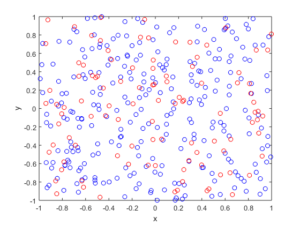
R

Python
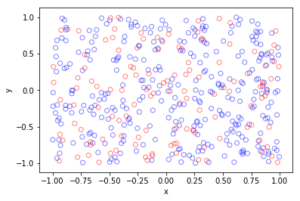
Spatially dependent thinning
Observe how there are more thinned points (that is, red circles) near the origin, which is of course where the thinning function \(p(x)=\exp(-|x|^2/s^2)\) attains its maximum.
MATLAB
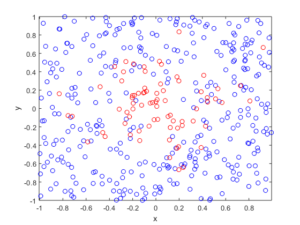
R
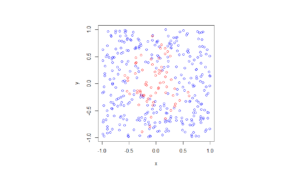
Python
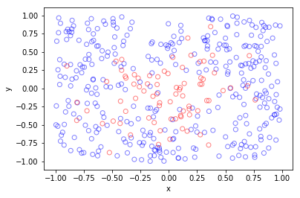
Further reading
The thinning operation is covered in Stochastic Geometry and its Applications by Chiu, Stoyan, Kendall and Mecke (Chapter 5). It is also covered in the book Statistical Inference and Simulation for Spatial Point Processes by Moller and Waagepetersen (Section 3.2.2). Kallenberg presents a more theoretical and rigorous take on thinning Poisson point processes in his new book Random Measures, Theory and Applications (Chapter 3). (A point process can be interpreted as a type of random measure called a random counting measure because it gives the random number of points in a set.)
Thinning is also covered in books that apply point processes to wireless networks, such as Stochastic Geometry and Wireless Networks by Baccelli and Błaszczyszyn (Volume 1, Section 1.3.2) or Stochastic Geometry for Wireless Networks (Section 2.7.3) by Haenggi. These books also give examples of thinning point processes for wireless network applications.


Hello,
I am a student at the University of Lorraine in France, doing my master’s degree. I am working on spatial point processes, specifically Markov point processes. I was wondering if the thinning process also applies to this kind of process. If so, how does it differ from a Poisson point process? Thank you for helping me out.
Respectfully,
Jona Ceka
Hi Jona,
Thanks for your email. Your question is a good one, but we have to be careful with the details.
First, the terms Markov point process vs Gibbs point process. As far I can tell, Markov point process is another name for a Gibbs point process; see book by Møller and Waagepetersen, where they use the terms interchangeably. But for some people, they mean something slightly different; see remark at the top of page 46 in the book by van Lieshout. Gibbs is the term preferred by the physics community. And perhaps there was a difference originally (perhaps regarding finite or infinite spaces), but now I think the two terms have merged into one.
Now we have to be precise by what type of thinning you mean.
If it is (statistically/stochastically) dependent thinning, then no. In general, with dependent thinning, the thinned point process will not be another Markov process, even if the original (unthinned) one is a Markov point process. This is the same case with a Poisson point process. The dependent thinning breaks it. This is certain.
If it is (statistically/stochastically) independent and spatially independent thinning, so you remove points with just a constant probability p, then, I believe, yes. I believe the thinned point process will be another Markov point process, but with modified moment measures. I should be able to give you an immediate proof of my belief. But I can’t. Nor can I think of any reasons why it wouldn’t be true (that is, I can’t think of a good counterexample). But I can point you in the right direction.
First of all, check out this unpublished book (by respected researchers in the field):
https://hal.inria.fr/hal-02460214
Search the words “thin” or “thinning” to find some interesting results. For example, the Laplace functional characterizes a point process. (By which, I mean two point processes with the same Laplace funtional are equal to each other — in distribution, I should add, to be mathematically precise.) Moment measures also characterize point processes. If you start with any point process and you thin it, you can write down its new Laplace functional and moment measures; see Proposition 2.2.6. A similar result is also given in the book Random Measures, Theory and Applications by Kallenberg.
Now you just need to apply the result to a Gibbs or Markov point process, which are defined in relation to a Poisson point process; see Definition 2.3.9 in the above manuscript, as well as the books by Møller and Waagepetersen or van Lieshout. I want to say that (statistically and spatially) independently thinning a Markov point process is equivalent to thinning the original underlying Poisson point used to define the original Markov point process. Then all you need to do replace each n-th order moment measure M^{(n)} with (p^n)M^{(n)}; see, for example, combine Proposition 2.3.24 with Lemma 3.2.6 in that unpublished manuscript.
But I don’t have time to check that belief and I thought there would be a more obvious answer. I’ll think about it. At any rate, I hope this helps.
I would also suggest looking at these papers (particularly, the first tutorial):
https://arxiv.org/abs/1512.05871
https://people.math.aau.dk/~jm/thinning8c.pdf
Also, if you independently thin a determinantal point process, you get another determinantal point process with modified moment measures. These point processes can be considered as a (nice) subclass of Gibbs point processes. See the following paper for more details:
https://arxiv.org/abs/1205.4818
PS There’s the question about a (statistically/stochastically) independent but spatially dependent thinning. That answer depends on answering the above question. In general, the thinned point process will not be spatially homogeneous, if the original point process was not spatially homogeneous.
I will look further into this but thank you so much for your explanations, they helped a lot !
You’re very welcome.
Hello,
I’m a PhD student at Ecole des mines Saint Etienne, France. I’m working on point processes also, and I was wodering if it is possible to apply a p(x) thinning to Matérn Type II point process in order to have a non-homogeneous spatial distribution for my points?
And if not, is it possible to use an intensity function to generate non-stationary poisson point process, then apply the Matérn type II thinning process?
Thanks in advance.
Regards
Hi Kassem,
Thank your for your post and sorry for the slow response.
It is definitely possible to apply a p(x) thinning to Matérn Type II point process. You can just do it. It will work in simulations and it will exist mathematically.
And yes, you can do the thinning before on the homogeneous Poisson point process, then apply the Matérn operation (of dependent thinning), thus creating a Matérn Type II point process that is inhomogeneous. For example, this comment: “inhomogeneous Matern hard-core processes (the unthinned Poisson point process is inhomogeneous)” in this paper (the first author is well-known in spatial statistics): “A Review of Inhomogeneous Markov Point Processes”
https://projecteuclid.org/ebooks/institute-of-mathematical-statistics-lecture-notes-monograph-series/Selected-Proceedings-of-the-Symposium-on-Inference-for-Stochastic-Processes/chapter/A-Review-of-Inhomogeneous-Markov-Point-Processes/10.1214/lnms/1215090697
You can do whatever you want. But I sense you are asking something more. Will you create a point process with nice properties? I don’t know. Most of the work assumes that the point process is homogeneous. In statistical settings, when the data seems to be not homogeneous, they may apply transformations to try to make them homogeneous.
I recommend looking at the references at the bottom of this post:
https://hpaulkeeler.com/simulating-matern-hard-core-point-processes/